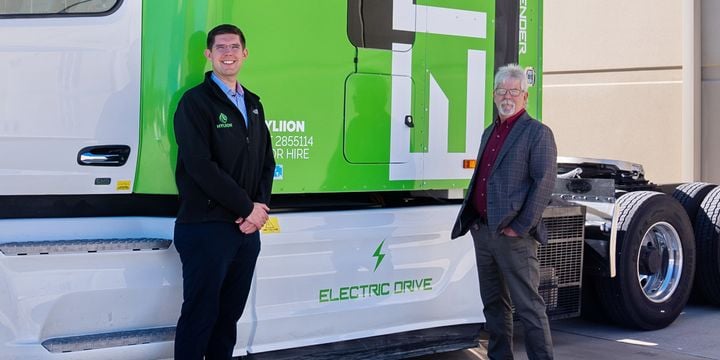Trucker Access › Forums › Diesel News › Q&A: Hyliion CEO Talks the ERX Hypertruck, Future of Natural Gas – Fuel Smarts
- This topic has 0 replies, 1 voice, and was last updated 11 months, 1 week ago by
 EazyRiDer66.
EazyRiDer66.
-
AuthorPosts
-
May 11, 2024 at 12:30 pm #19974
 EazyRiDer66Keymaster
EazyRiDer66Keymaster

HDT Equipment Editor Jim Park (right) sits down with Hyliion’s founder and CEO Thomas Healy to discuss the future of natural gas as a motor fuel, the pathway to zero-emissions long-haul transport and more.
On a visit to Hyliion in Austin, Texas, HDT’s Equipment Editor Jim Park recorded an interview with founder and CEO Thomas Healy. Earlier in the day, Healy had accompanied Park on a test drive in the company’s ERX Hypertruck. Park had driven Hyliion’s battery-electric Hybrid 6×4 HE truck in October 2018, and was anxious to take the new truck for a drive.
There was much to discuss beyond the truck itself, including the future of natural gas as a motor fuel, the pathway to zero emissions long-haul transport, and the pros and cons of the ERX compared to the alternatives.
Healy founded the company in 2015. He’s a mechanical engineer, a racing buff, and an ambitious entrepreneur. Those attributes imbue him with an infectious enthusiasm for the work his company has taken on, but he’s pragmatic too. He’s already looking beyond the ERX’s “here, now” position, to a future powered by hydrogen.
This conversation is an abbreviated version of the full interview. You can listen to the full interview on HDT’s podcast channel, HDT Talks Trucking, or watch an edited version of the interview on truckinginfo.com.
This interview has been lightly edited for length and clarity.
HDT: Let’s begin with a few questions about the truck. With the storage tanks and batteries on board, you’ve got the worst of both worlds here in terms of weight. How do you justify the two of them? And roughly what does that truck weigh?
Healy: We’re still locking in what will be the actual go-to-market weight of vehicle. We haven’t come out with a number yet, but to put some ballparks to it, it will be heavier than a diesel truck. Because as you mentioned, we can’t have both systems. But we’re expecting that it is going to be lighter than a conventional BEV plug-in truck because we don’t need the massive battery pack that a BEV needs to get the range. We also get the 2,000-pound government weight allotment (for natural gas trucks) which means we can actually have a gross vehicle weight of 82,000 pounds rather than 80,000. So, more to come on that. You know there is a weight penalty because of the additional components, but it’s not as bad as some of the other solutions.
HDT: Can you scale down the natural gas tankage? Could you get away with two or three tanks if you don’t need the full 1,000-mile advertised range?
Healy: Absolutely, and you hit nail on the head. The vehicle that we’re first bringing to market is all the bells and whistles, right? It’s got the biggest natural gas storage tanks allowing us to get up to 1,000 miles of range. But not all fleets are going to need that. This truck has a 175 diesel gallon equivalent, but we could go to a 135 DGE. There are tanks as small as 60, or 65, DGE. If a fleet is more weight sensitive, we can just scale down the size of the tanks.
HDT: Which natural gas engine are you using in the ERX?
Healy: The go to market solution is the 12-liter Cummins engine (ISX12N). This isn’t a brand new engine; it’s been on the market for a while. The big undertaking right now is the [California Air Resources Board] certification process. We need that certification before we bring this into production. We announced a handful of months ago that we’ll be doing that jointly with Cummins, which has been a big help.
Longer term, our plan is to evolve with the Cummins portfolio. While they still haven’t come out with all the details yet of when the new (15-liter) engines will come online but our plan will be to evolve with the Cummins portfolio.
HDT: The truck I drove today was a Peterbilt 579. I also saw a bunch of Freightliner Cascadias out back all suited up. Those obviously are two of the OEMs that you’re in league with so far. Do you have any other OEMs looking at this new powertrain?
Healy: We’ve installed our Hybrid drive system on all the major truck OEMs, including both Paccar brands, Peterbilt and Kenworth, and Freightliner, Volvo, and Navistar as well. With the ERX Hypertruck system, we’re going to market on the Peterbilt 579. We have developed a great relationship with Peterbilt. There have been a lot of hurdles that needed to be worked out, like who gets the credits. In order for the credit to go to the OEM, the OEM has to put the final VIN on the vehicle. We’ve been able to work through a lot of that with Peterbilt. We are still working through how best to build the truck to be ready for the Hyliion system. The way that process works is you start by buying full vehicles from the OEM and you tear out all the stuff you don’t need before installing your system. That’s how everyone starts. Next, you get to a point where the OEM starts to de-content the truck before shipping it to you. After that, they’ll put some of the components on for you. And eventually you get to being online. Our goal is to follow that same progression with Peterbilt and the other OEMs at their mod centers for upfits as well. And the long-term goal is this is to be an assembly solution.
HDT: Natural gas is in regulatory limbo right now. The California Air Resources Board (CARB) and Environmental Protection Agency (EPA) don’t seem to like it that much. Most of the incentives offered by various agencies lean toward battery electric rather than natural gas. Where do you see natural gas over the long term? Will it be around 10 or 20 years from now?

Hyliion Founder and CEO Thomas Healy
Healy: Frankly, I don’t see a future in this country where we’re not heavily using natural gas for many years to come here. From that standpoint, we should be using it in semi-trucks as well. And in terms of the political environment, is it being accepted or not? Just look at the Inflation Reduction Act. Our vehicle qualifies for the same exact amount of money as a battery-electric plug-in truck or fuel cell truck.
In California, specifically, our vehicle is going to qualify for 75% of a ZEV (zero emissions vehicle) credit compared to a plug-in truck that qualifies for 100%. They’re saying, “hey, you’re not quite as good as a plug-in, but you’re close.” We could spend hours talking about this one, but my pet peeve is this: we need to look at this from a well-to-wheel standpoint. This whole philosophy of “it’s just what comes out of the tailpipe that matters” is so wrong. You know, if you’re going to use a coal fired power plant, or a petroleum-based power plant, charge an EV, you’re not doing anything positive for the environment.
HDT: Hyliion makes a big deal about running on renewable natural gas. RNG can have a significantly lower global warming potential, but it still produces some amount of particulate matter and NOx. Where does renewable natural gas fit into this picture?
Healy: Renewable natural gas is basically a way of using a pollutant as a fuel. RNG is basically captured methane that comes off landfills, wastewater treatment plants, and dairy farms. Producers capture that methane, clean it up and pump it into the pipelines to use as a fuel. Instead of that methane rising into the atmosphere as a harmful chemical, we’re using it to run a truck. And what comes out of the tailpipe is a lot cleaner. That’s what’s giving us this ability to be net carbon negative. If it had just gone off into the atmosphere, that would have been worse for the environment than what’s coming out of the tailpipe. So, if you’re below zero from an emissions standpoint, I don’t know that you can really beat that one. If you look at the grid right now, only about 20% of that energy is coming from renewable sources such as wind, solar and hydro. So, we think RNG makes a tremendous amount of sense.
HDT: Let’s talk about emissions credits. Where will the credits go with a truck like the ERX? Is it your credit, or is it the OEM credit? Do fleets get any credits for buying a truck like that?
Healy: The credits we’ve been focusing on are related to the two CARB mandates that are coming out. There’s the Advanced Clean Truck (ACT), which is the mandate being put on the OEM, and then there’s the Advanced Clean Fleet (ACF), which is the mandate being put on the trucking fleets. So for Advanced Clean Truck, both qualify for ZEV credits, so our goal is these credits are going to the OEM or the fleet, not to Hyliion. The ERX truck qualifies for 75% of one ZEV credit — just a little bit less than a plug-in vehicle or fuel cell truck. But for the fleet mandate one (ACF), we’re actually going to qualify for 100% of a ZEV credit based on how it’s written today. For fleets, there’s no greater benefit in going to a plug-in truck over our truck.
HDT: I want to ask you about the price of these zero-emissions trucks. While we were out in the truck, you mentioned that fleets might be resistant to adopting fuel cell trucks, specifically, until costs come down and infrastructure gets built out. What are you hearing regarding pricing for those trucks and how does that compare with your ERX?
Healy: Just as a high level, the rough numbers, inclusive of the IRA credits that are coming out, suggest a fuel cell truck will come to market at between $500,000 and $600,000. BEV plug-in trucks are going to come to market in the mid-$400,000 range. Our truck is going to come out to be in the high $300,000s. And when you compare it against a diesel, all of us are more expensive.
What you need to look at is the cost of operation. For the fuel cell truck, hydrogen costs are around $10 a kilogram or $10 a gallon ballpark. Right now, plugging into the grid and recharging will be around $4 a gallon [equivalent] while renewable natural gas will be in the dollar-a-gallon range. We’re not only going to be significantly less than the other alternative fuels, we’re also significantly less than diesel from a fuel cost standpoint. So, if you just run the math of kind of upfront vehicle costs, and then you extrapolate the fuel cost over time, you’ll see an ROI of about three years with our solution compared to a diesel.
HDT: One of the touted benefits of a full BEVs is lower maintenance costs because there are fewer moving parts. You’ve got a lot of those moving parts, so how do your long-term maintenance costs compare with a diesel? Because you’re only running the engine some percentage of the time and not running it as hard, do you expect the maintenance cost to be lower than what you would see with a full-time natural gas engine?
Healy: What I’ll say is: Time will tell. It’s still too early on to really know what the maintenance costs are going to be. But if you look at this conceptually — what should happen — we’re not going to be as low maintenance as a BEV plug-in truck because, as you mentioned, we still have an engine and a generator under the hood. With that being said, we’re operating the engine in a more efficient zone, right, and we try to keep the engine in its sweet spot, as opposed to going through big RPM oscillation. There will be less wear and tear on that engine, so that should help extend engine life. By how much? We don’t know yet. That’s some of the things we’re going through in testing right now.
HDT: You’ve talked about migrating to hydrogen sometime in the future. First, with an internal combustion hydrogen engine of some sort, and eventually a fuel cell. How far out is that?
Healy: We’ve laid out a three-stage roadmap. The first is a natural gas internal combustion engine — that’s the power plant we now have onboard. Step No. 2 is the Karno generator, which is a new fuel agnostic generator we just acquired from GE.
I’ll start with the ICE. That’s going start a production late 2023. We expect to release the Karno solution a few years after that. We haven’t put a timetable to the fuel cell yet, but our goal is by the time that infrastructure is built out, by the time fleets are really moving over to hydrogen and really want a hydrogen solution, we’ll have a fuel cell solution ready by then. All that being said though, we actually see the Karno generator as being one of the biggest differentiators for us. Not only can it operate on about 20 different fuels it can also operate at a much higher efficiency than an ICE or even a fuel cell can operate. From that standpoint, we will have a hydrogen solution with the Karno generator as well.
HDT: What is a Karno generator? It sounds like 100-mile-per-gallon carburetor to me.
Healy: A flux capacitor… [laughs] Sometimes it feels like that when the engineers are explaining it to me. Actually, it’s really neat. It’s a linear heat generator. It can run on a variety of different fuels, including natural gas, hydrogen, diesel, and others, to produce heat. And that heat drives a linear generator which has an electric motor in it to produce electricity. And that’s the genset.
Linear generators are not new. They’ve been around for decades. We acquired the technology from GE, who made a couple of big advances with it. First, we use the same fuel injection technology used in the GE jet aviation engines, so efficiency wise, it’s fantastic. The second benefit is it also has components that are made through 3D additive manufacturing — 3D printing. From an efficiency standpoint, we can rethink the way these components are designed and get much better performance out of them compared to conventional manufacturing. When you couple those two things together, you have a solution that is fuel agnostic, and has a very high efficiency.
HDT: If I wanted to buy an ERX today, who would I talk to, Peterbilt or you?
Healy: At launch, Hyliion will be the one selling the complete asset. Initially, trucks will be sold through us and then eventually we’ll work to actually moving the model to where we’ll sell the powertrain to the OEM and the OEM will have us as a data-book option.
HDT: Hyliion started life making electric pusher axles for trailers for a little extra propulsion or fuel savings. The makers of transport refrigeration equipment tell me somehow procuring enough energy to keep a reefer unit running for more than a few hours is a real challenge. Is Hyliion looking at dusting off the electric trailer axle anytime soon to help the reefer people out?
Healy: [Laughs] We haven’t put it back on our product roadmap, officially, but we do own many patents in that area. Powering reefers, I think, is something we want to participate in long-term. There’s no reason why we can’t supply electricity from our natural gas generator to power a reefer. Or maybe down the road we break out one of the trailer axles from a while back. We have one of them out in the shop. We still see some value there, and we feel like we’ve got pretty good coverage on the IP side.
-
AuthorPosts
- You must be logged in to reply to this topic.